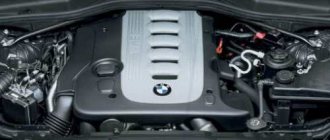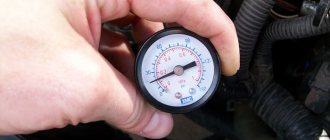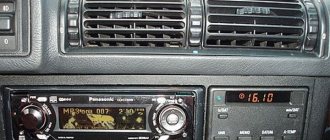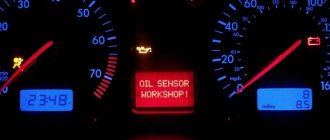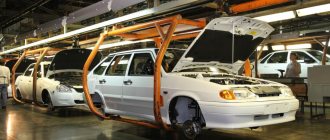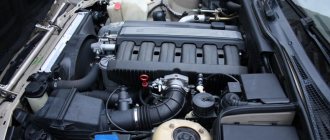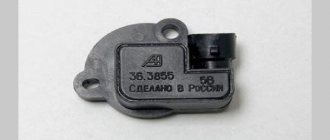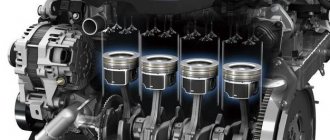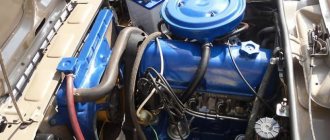The impetus for writing this post was a real repair at the request of a client, which consisted of a simple replacement of the vacuum booster, but isn’t it true that the engine may be tripping for the wrong reasons... In this post I want to consider the main reasons for this most unpleasant phenomenon, as well as methods for diagnosing and troubleshooting repair.
Let's start with the signs that the engine is running rough. “Engine trouble” - by this we mean that one or more cylinders are not working. Accordingly, the engine does not develop full power, does not have the necessary traction force, fuel consumption increases... But we all already know this, closer to the point.
The main causes of the problem if the engine starts to trip
Many drivers believe that the engine only idles at idle, and while driving the non-working cylinder is connected. In fact, this is not true. If the power unit idles at idle, it means that the cylinder also does not work when driving. This can result in excessive unused gasoline entering the crankcase, diluting the oil to a too thin state and losing its performance properties.
If the power unit in your car starts to fluctuate at idle only when cold, we recommend changing the oil. Its viscosity may be too high for the unit. If, even when the car is warm, the non-working cylinder does not turn on, then it is necessary to pay special attention to the following possible problems in the power unit system:
- high-voltage wires and spark plugs may be faulty - this is the simplest possible problem;
- perhaps the cause of the problems is a completely clogged injector, which does not spray fuel, but pours it like a river;
- on old carburetor cars, the car could stall due to a malfunction of the idle speed sensor, oddly enough;
- also, on any gasoline and diesel car, the intake or exhaust valve may break;
- Loss of compression in one of the cylinders is also often the reason why the unit begins to fail.
Wires and spark plugs can be replaced yourself. Even if they are not the reason, you will completely remove this issue and be able to pay attention to more specific possible options for the problem. Checking the fuel system and cleaning the injector will also not harm your car, but this process should be performed by specialists.
Also the valve system must be checked. Sometimes the valves get stuck and won't open to accept fuel, and in some cases the valves haven't been adjusted for too long, the clearances are off, and the valve can't do its job. But these are not the most expensive problems in this case.
Stalls at idle
The reasons for stopping the power unit at idle may be:
- Malfunction of the XX regulator. You can check the functionality of the XX sensor in the following way: try to start the car and press the gas pedal while cranking the starter. As soon as the engine starts, you should release the pedal and look at the speed; if it fluctuates, the problem lies precisely in the XX sensor.
- In other cases, when your VAZ (injector) starts and stalls, the problem lies in a malfunction of the throttle valve. This part should be washed.
- Sometimes flushing does not fix the problem. In this case, the reason lies in the throttle position sensor. To solve the problem, you will have to replace the sensor.
Manifestation of malfunction
First, you need to make sure whether your problem really fits the definition of “engine trouble.” To better understand the cause of the occurrence, you need to understand the very essence of the malfunction, and at the same time decide whether your dilemma is similar to the one described below.
So, what happens to the car and what changes in engine performance can occur? To begin with, as we said earlier, the engine life will noticeably decrease. This is especially noticeable in cars with manual transmission (we'll talk more about this below). In addition, the most likely thing is that the car will begin to shake and vibrate while driving. Vehicle acceleration deteriorates sharply, operating speeds decrease, and the level of fuel consumed increases by almost several liters.
Cylinders are the most important indicators of normal engine operation
We recommend: What to do if the engine stalls?
The fuel pump screen is clogged
For cars of the VAZ family with an installed injector instead of a carburetor, it is typical that the car starts and stalls. Sometimes the reasons for the engine stopping on its own are due to a malfunction of the fuel pump. If the car stalls immediately after starting, but then starts, the problem lies in a clogged fuel pump cleaning screen. In this case, you need to replace the mesh with a new one and enjoy the further movement of the car.
In other cases, it happens that the car starts perfectly when cold and does not even stall, but as soon as it warms up or at hot temperatures outside, it begins to twitch. What is the problem if the engine starts and stalls when cold? It is hidden in the performance of the fuel pump. Sometimes such signs are characteristic of poor fuel quality. This is also caused by a clogged pump screen.
How to identify a breakdown - the main symptoms
The term “engine throttles” itself means that not four of its cylinders are working stably, but three (possibly two). For six-cylinder units, “triple” means stable operation of only five of them. But this does not change the essence - the combustible mixture does not ignite in one or more cylinders. As a result, strong vibration occurs, as the operation of the internal combustion engine becomes unbalanced.
In addition, there are other signs of this malfunction:
- Reduced power. If the engine is four-cylinder, failure of one cylinder reduces this figure by a quarter.
- Increased fuel consumption. The combustible mixture does not burn in the cylinder, but simply flies out into the exhaust pipe.
- Popping sounds from the exhaust pipe. They arise for the reason described above - the combustible mixture explodes in the manifold and exhaust pipe, and not in the cylinder.
- Unstable speed. This symptom can be noticed both by ear and by the tachometer needle, which constantly “jumps”.
- The engine does not start well. If there is a lot of friction, starting the engine becomes a real problem, especially when it’s cold.
It is not difficult to determine the constant tripping of the engine - strong vibrations and loss of power are impossible not to notice even for a beginner. But not always one of the cylinders fails completely. Most often, motorists have to deal with “tweaking”. With such a malfunction, the cylinder works, but the explosion of the mixture occurs unstably, that is, with skips. The signs of “tweaking” are the same as with regular tripling, but they are not so pronounced. Therefore, you should pay attention to all symptoms at once.
Identification of an inactive cylinder
This task is not difficult at all. The only thing to do is to turn off the spark plug caps one by one while the engine is running. If a properly functioning cylinder is disconnected, the engine sound will immediately change. And if, when removing the tip from the spark plug, the sound of the engine remains the same, then this is a faulty inactive cylinder.
When disconnecting high voltage wires, you need to do it carefully, as you can get an electric shock. Anyone who has already encountered this knows that there is little pleasure in such an electric shock. To somehow protect yourself from this, it is better to put dielectric material under your feet in the form of a rubber mat, dry board, etc. You must turn off the spark plug by holding the wire, not the tip, and do not touch the car body.
Causes of “triple tripping” of a VAZ car engine
- Incorrect ignition timing
- Air leak in the vacuum brake booster system
- Spark plug fault
- High voltage wire breakdown
- Capacitor failure
- Loss of tightness in the intake manifold area (intake manifold, carburetor)
- Burnout of valve, piston
- Broken piston rings
- Incorrect valve adjustment
- Destruction and wear of rockers (valve levers)
- Cylinder head gasket failure
- Wear, hardening, destruction of valve stem seals
- Very low fuel quality
- Incorrect carburetor adjustment
- Wear of distributor shaft, rotary plate bearing
- Loss of tightness of the membrane of the vacuum ignition advancer
- I do not take into account the use of spark plugs that are not suitable for the engine and other “faults”.
Perhaps not all the reasons, but what I could remember, if you have anything to add, then write in the comments.
Important!
You can determine a bad cylinder using a simple, old and reliable method - one by one removing the high-voltage wire from the spark plug. You have to be very careful here, because you can get electrocuted! To carry out this manipulation more safely, you need to stand on a dielectric (rubber, wood), take a clean, dry rag, remove it by the wire, and not by the cap, and do not touch the car body at this time. It is very easy to check; use a choke to increase the idle speed to 1500 rpm and remove the caps from the spark plugs one by one. If the speed drops when the cap is removed, then the cylinder is working; if there is no difference, then the cylinder is not working.
Well, now let's talk about each of the reasons in more detail.
- Incorrect ignition timing. With this option, I personally know not a tripping, but a seemingly slamming of the engine (missing), which is accompanied by “bouncing” of the entire engine. This is especially noticeable at idle; as the speed increases, the skips disappear. Most likely, your ignition is set too early; this may also be indicated by jerky cranking of the engine by the starter when starting.
- Quite often, the cause of engine tripping in a VAZ of all models (except for the VAZ 2101, which does not have a vacuum brake booster) is a loss of tightness in the hose, diaphragm, or valve. As a result, excess air appears in the intake manifold, which leads to over-leaning of the mixture and misignition of the mixture in the cylinder, as a result of which the spark plug may become wet and stop igniting the compressed mixture.
- A faulty spark plug is one of the most common causes of engine misfiring. There is nothing special to tell here, it is important to remember and replace spark plugs regularly, and the presence of a spark on an inverted spark plug at atmospheric pressure does not indicate its full functionality, because ignition occurs under much more difficult conditions (Za Rulem magazine, dating back to Soviet times).
- At this point I will combine the breakdown of the high-voltage wire and the capacitor on the contact ignition system. A wire breakdown can be determined by replacing all the wires, as well as the capacitor. You can also try to determine the breakdown of the wire by looking at them in complete darkness; if there is a breakdown somewhere, you will see flashes.
- Loss of tightness in the collector area, as a rule, does not occur on its own. More often this happens due to incorrect assembly or bad gaskets. I also had a case where they complained about trimming at idle. The reason was the elimination of the vacuum ignition advancer and the unplugged vacuum tube on the carburetor.
- As a rule, when a piston or valve burns out, the cylinder stops working altogether or does not work for a long time. It can only be determined by measuring compression and opening the engine.
- Breakage or sticking of piston rings is also not a very common occurrence, because a number of conditions are necessary for its occurrence. You can check it by measuring the compression; if it turns out to be low, then eliminate cylinder head malfunctions in a simple way - pour a little oil into the cylinder; if the compression increases, then there is a malfunction in the piston system.
- With incorrect valve adjustment, everything is already clear - any valve may not open or close completely. Proper valve adjustment can cure this problem. Rocker wear can cause a similar problem. The valve stops opening correctly and the cylinder stops working.
- Well, now let’s briefly go over the problems that may arise with the distributor. Quite often, on not new machines, wear of both the shaft itself and the bushings in which it rotates occurs, as a result of which it becomes impossible to establish an adequate gap between the contacts. The same thing happens if the swing plate bearing is worn out. Also, misfires can occur due to depressurization in the vacuum ignition timing advancer, where the membrane may fail.
We recommend: How to repair a power steering pump with your own hands?
The valves are malfunctioning
When the engine starts and stalls, the cause of the breakdown is hidden in the operation of the valves (this applies to the gasoline model of the engine). Diesel options are characterized by a decrease in fuel pressure. For repairs, you should contact a service station, where they will carry out appropriate diagnostics and adjust the valves and adjust the operation of the timing belt.
Problems most often can be:
- Unadjusted valves and uneven clearances do not allow the engine to operate stably.
- Valve deformation. Replacement with subsequent adjustment of the timing will be required.
- Overcooling of the power plant, which prevents normal warming up at startup.
- Diesel fuel is frozen in the pipes.
Each of the listed breakdowns can occur with a car, and the issue can only be resolved with the help of appropriate specialists. When the driver has the skill to adjust the timing belt, you can do the repair work yourself. If malfunctions are observed in winter, you should, if possible, put the car in a warm box for a while, and the problem of starting/stopping the engine may disappear on its own.
Loss of compression and lack of operation of one of the cylinders - overhaul
If all the verification stages described above did not give the desired results, you will have to resort to the last possible problem. Check the compression in the cylinders. This can be done at a service station; the procedure will not take too much time.
Lost compression in one of the cylinders will cause it to not work, so the engine will require major overhaul. After disassembling the power unit, it will be clear what kind of repair the engine needs, but the most common repair procedures are as follows:
- replacing piston group elements with new parts;
- boring the cylinder block for a larger piston diameter;
- removing signs of increased metal wear in the engine;
- rendering a verdict on replacing the power unit.
In the first three cases, you can get away with a relatively small amount of money. But some owners of modern cars will find, to their dismay, that major engine repairs for their vehicle are unacceptable. In this case, you will have to look for a contract or new engine to replace the old one.
This will cause significant costs for car repairs. Interestingly, many car owners bring the engine to the point of needing major repairs with their own hands. It is simply too late to notice that the engine is running rough and requires minor repairs. In this case, further operation will require repairs.
See more information about the reasons why the engine troits in the following video:
Vacuum
If there is no vacuum, the engine will also stall after starting. This situation is relevant for carburetor engines.
There may be no vacuum in the carburetor itself, or in the vacuum hoses and intake lines. This contributes to the disruption of the correct formation of the air-fuel mixture. Therefore, the motor cannot work normally.
How to solve a problem? Easily. Carry out diagnostics of vacuum lines. If you notice signs of depressurization, they will have to be eliminated. It is better to replace damaged hoses and pipelines immediately.
How to understand what is wrong with the engine
It is very important to identify the problem in time, find the cause and begin to properly eliminate it. Otherwise, ignoring or unqualified assistance may result in costly major repairs.
One of the possible manifestations of the problem is a situation where the engine idles at idle speed. To be more precise, there is instability at idle speed, and the electronics often demonstrate increased fuel consumption. To make sure of this, you should check which of the cylinders needs repair or complete replacement. You can read more about this procedure, as well as other probable causes, below.
Check the wiring for a breakdown
We recommend: Is it possible to remove a chip from a windshield and what is needed for this?
Analyzing and fixing the problem
If the ignition is set incorrectly, the engine jerks and slams. It must be listened to in low operating mode. With a strong mode, the work is leveled out, and skipping beats is not heard. Early ignition manifests itself in jerks when cranked by the starter.
A damaged hose, valve, or diaphragm of the vacuum brake booster allows air to leak from the atmosphere. Excess air leans the fuel mixture. The spark plug gets wet and cannot create a normal spark to ignite the mixture. The fault can only be identified experimentally.
When a cold engine revs heavily, this indicates a problem spark plug. Its appearance speaks volumes to an experienced mechanic. The normal color of the insulator is light or slightly brownish. Oil traces and carbon deposits on the insulator indicate that the spark plug is being filled with an over-enriched mixture; there is no normal sparking. The spark plug body must be free of cracks and chips. It must be checked for spark quality. If sparking is weak, the spark plug must be replaced.
A breakdown of high-voltage wires and a capacitor occurs when the engine is not warmed up. This malfunction can be observed in the dark. Surface sparkling is noticeable on the wires and capacitor above. The resistance during measurements should not exceed 20 kOhm.
Burnout of pistons and valves is determined by measuring engine compression. The engine shakes constantly: cold, hot, loaded, at idle.
Low compression is the most serious cause of tripping
Sometimes the reason why an engine stalls is more serious than just a failed spark plug or unregulated mixture quality. The fact is that the mixture in the cylinder does not just ignite, but explodes. For this explosion to occur, a certain pressure must be provided. If the compression in the combustion chamber is lower than necessary, the cylinder begins to work intermittently or stops working altogether. Most often, diesel engines suffer from low compression, but gasoline internal combustion engines are not immune to this problem.
To check this indicator, a special device is required - a compression meter. It is installed instead of a spark plug and shows the pressure in the combustion chamber after the crankshaft rotates. Note that different cars have different pressures in the cylinders. Therefore, accurate information can be obtained from the reference literature from the manufacturer. If there is no way to know what compression should be in your car's engine, simply measure the pressure in all cylinders. It should be approximately the same.
If it turns out that in one of the cylinders the pressure is significantly lower than in the others, the reasons for this may be the following:
- Severe wear on compression rings and cylinder walls.
- Piston burnout.
- Valve burnout.
To troubleshoot problems, it is necessary to replace parts that have failed. It is not recommended to operate the vehicle until repairs are carried out, as more serious damage may occur .
Here, in fact, are all the most common reasons why the motor triples. As you can see, in most cases you can fix the problem yourself. But sometimes interruptions in the operation of the cylinders are a symptom of a serious breakdown, which cannot be solved without the intervention of specialists.
We check the ignition system - from simple to complex
The search for the cause of the malfunction should begin with the spark plug . If it has changed color and there is a lot of carbon on it, most likely it has failed. To verify this, simply screw in a new one and start the engine. If the replacement does not produce results, it is quite possible that the problem lies in the high-voltage wire itself. So try replacing it too.
Sometimes the engine starts to misfire as a result of a cap failure. Even a small crack is enough for a spark to start to “break through”. To detect such malfunctions, just start the engine and listen to the sounds in the area of the ignition system. If a characteristic electric crackling sound is heard, it means a spark is “breaking”. At night, you can even notice where exactly the outbreaks occur. If a faulty wire is used for a long time, darkening appears at the breakdown site.
If no problems with the wiring are identified, the cause of the malfunction may be the distributor or electronic sensors. To diagnose and correct such breakdowns on a modern car, you must contact a service center, since this procedure requires special computer equipment. The only thing is to carefully inspect the distributor cover first. Sometimes a crack in it can be detected visually.
Owners of modern cars often encounter the problem of tripping after washing the engine. Most often it occurs due to water getting on electronic sensors. To eliminate the malfunction, you need to blow out all the connectors and leave the car for a while in a warm box or in the sun with the hood open if the owner washed the car in the warm season.
Finally
In conclusion, we will give advice from experienced drivers. Even if the car suddenly starts idling, you should not panic or get upset. There is always a decent way out. The machine can move at low speed in idle mode to the nearest service station. You can get expert advice by phone or iPhone. Replace a faulty spark plug by purchasing one at the nearest gas station. If you are afraid of more severe damage, a tow truck will help deliver the vehicle to the repair site.
Before you start looking for the causes of this problem and finding out what it can lead to, you need to understand what it means to trip an engine. Otherwise, this phenomenon is called “missing” and means interruptions in the operation of one or more cylinders of an internal combustion engine. The term “troit” owes its appearance to a four-cylinder internal combustion engine. If one of the cylinders fails, only three work. As a result, the engine does not pull, this becomes especially noticeable during acceleration. Currently, a six- and even twelve-cylinder power unit can “triple”, although this is not entirely true from the point of view of the Russian language. As a visual aid, you can find a video of an engine throttling on the Internet, and there you can also find a video about what to do in such situations.
